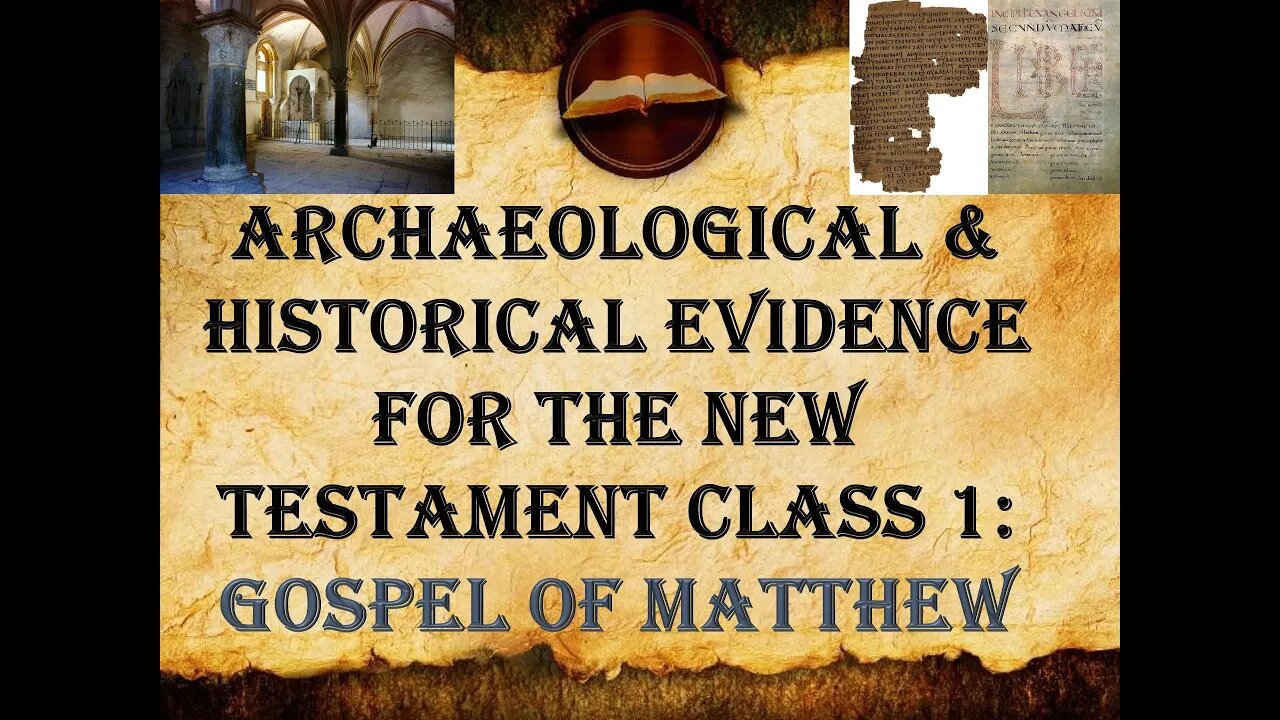Premium Only Content

Historical & Archaeological Evidence for the New Testament: Gospel of Matthew, Authorship & Date (1)
Class session 1 in a brief course on archaeological and historical evidence for the New Testament examines the authorship and date of the Gospel of Matthew. Much of the material comes from the study on evidence for the New Testament at https://faithsaves.net/archaeology-new-testament/.
The Gospel of Matthew was written by one of Jesus Christ’s Apostles named Matthew (Matthew 9:9). Matthew wrote his Gospel c. AD 40, that is, very shortly after Christ’s death and resurrection in AD 33. In accordance with the Jewish heritage of both Christ’s earliest followers and their earliest evangelistic outreach (Acts 1-7), Matthew’s Gospel, likely composed in Jerusalem, emphasizes the Lord Jesus’s character as the Messianic “King of the Jews” (Matthew 2:2; 21:5; 27:29, 37, 42; 28:18-20) predicted in the Old Testament. Matthew’s authorship of the gospel bearing his name, and its early date, receives overwhelming support from the extant historical sources.
The ancient testimony to Matthew’s authorship of his gospel is unanimous; attribution of this gospel to Matthew the apostle goes back to our earliest surviving patristic testimonies, and there is no evidence that any other author was ever proposed. As far back as we can trace it, and from the earliest manuscript attributions that have survived, it is always the Gospel kata Matthaion [according to Matthew].
Papias (born c. AD 60), who had direct contact with eyewitnesses of the Lord Jesus’ earthly ministry, who wrote around the end of the first century while the Apostle John was still alive, and of whom the earliest extant historical testimony indicates personally having heard the Apostle John preach, declared in his five-volume Exposition of the Oracles of the Lord: “Matthew ... composed the gospel.”
This witness to Matthew’s authorship is confirmed by the unanimous voice of other testimonies:
Irenaeus: “Matthew also issued a written gospel.”
Origen: “Among the four Gospels, which are the only indisputable ones in the Church of God under heaven ... the first was written by Matthew, who was once a publican, but afterwards an apostle of Jesus Christ, and it was prepared for the converts from Judaism.”
Eusebius: “Matthew, who had at first preached to the Hebrews, when he was about to go to other peoples, committed his Gospel to writing ... and thus compensated those whom he was obliged to leave for the loss of his presence.”
Jerome: “Matthew, the tax collector, who is also named Levi [cf. Luke 5:27] ... published a Gospel in Judea ... chiefly for the sake of those from the Jews who had believed in Jesus[.]”
The Matthew who occupies a place in all the lists of the Apostles in the NT is the only person who has ever been regarded as the writer of the Gospel which bears this name. Only in the eighteenth century A. D. did anti-Bible skeptics begin to question Matthew’s authorship.
Alongside the powerful case for the authorship by the Apostle Matthew of the gospel bearing his name, an early date for the gospel receives powerful confirmation. The Biblical book of James, written c. AD 45, shows a knowledge of Matthew’s Gospel and contains over thirty-five parallel passages with Matthew’s Gospel. Hence, if James was written around AD 45, then Matthew’s Gospel had to be written earlier. From the middle to late first century, the earliest extant post-Biblical writings of Christendom such as the Epistle of Barnabas, 1 Clement, the letters of Ignatius and Polycarp, and the Didache contain quotations from and allusions to Matthew as Scripture, clearly evidencing the existence of the Gospel by that time.
The internal evidence within Matthew support a date after the resurrection of Christ in AD 33, but by no means later than AD 70—the temple and city of Jerusalem, which were destroyed by Rome in AD 70, were still standing when the Gospel was composed (Matthew 5:23-25; 17:24-27; 23:2-3, 16-22). Indeed, the language of Matthew suggests that the twelve apostles were all still alive when he wrote, dating the Gospel before the martyrdom of James in AD 42. The external evidence points specifically to c. AD 40. Many high quality Greek manuscripts record a very ancient tradition that Matthew was published eight years after the ascension of Christ, that is, in AD 41. Eusebius in his historical Chronicon or Chronicle placed the writing of Matthew in AD 41. Cosimas of Alexandria dated it very shortly after the crucifixion and resurrection of Christ, that is, c. AD 35. Subsequent writers on the subject such as Theophylact date the gospel between c. AD 38-41. A comprehensive study of all the external evidence demonstrates that “there is no trace of a tradition that dates the gospel [as late as] the last decades of the first century”—a date very shortly after the time of the events recorded in the gospels receives universal testimony.
Matthew, wrote his eyewitness account of the life of Christ c. AD 40, only a handful of years after the events he recounts took place.
-
 5:59:47
5:59:47
SpartakusLIVE
9 hours agoThe HUGEST Brain (not forehead) delivers Saturday SPARTOONS || Variety Later - Shadow of Mordor
181K4 -
 2:34:20
2:34:20
Barry Cunningham
10 hours agoPRESIDENT TRUMP WELCOMES FOOTBALL SEASON! AND MORE BREAKING NEWS!
72.6K48 -
 54:47
54:47
Side Scrollers Podcast
13 hours agoSide Scroller Presents KING OF THE KART | MASSIVE MARIO KART TOURNAMENT
41.7K -
 4:12:33
4:12:33
Mally_Mouse
13 hours ago🔥🍺Spicy HYDRATE Saturday!🍺🔥-- Let's Play: Baldur's Gate!
34.2K3 -
 2:26:32
2:26:32
BooniesHQ
9 hours agoGame Of SKATE Shaun Hover Vs. Jeff DeChesare: Boonies Skate Night 1
108K5 -
 3:56:19
3:56:19
MissesMaam
4 hours agoAmong Us 3D (ft. Rumblers) 💚✨
11K1 -
 LIVE
LIVE
S0lidJ
4 hours ago🟢Live - S0lidj - Solo Snipes
49 watching -
 17:08
17:08
Exploring With Nug
1 day ago $2.74 earnedMassive Thunderstorm Hits During Search for Missing Georgia Woman!
27.5K1 -
![RCP #29🤟 [FR/ENG] 🤟 Satisfactory trying to grow a beautiful Factory, possible other Game later 🤟](https://1a-1791.com/video/fww1/98/s8/1/o/q/N/d/oqNdz.0kob-small-RCP-29-FRENG-Satisfactory-t.jpg) 8:05:52
8:05:52
Deaf Gamer Girl
10 hours agoRCP #29🤟 [FR/ENG] 🤟 Satisfactory trying to grow a beautiful Factory, possible other Game later 🤟
3.97K -
 LIVE
LIVE
Cewpins
4 hours agoSmoke Sesh!🔥Let's Get LIT!!!🍃420💨!MJ !giveaway
51 watching